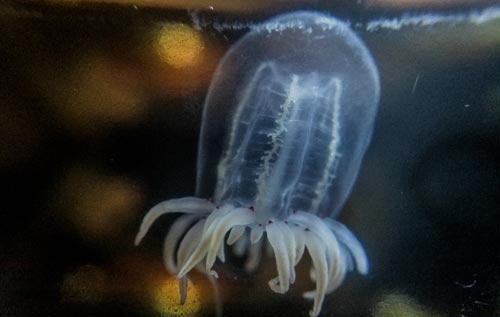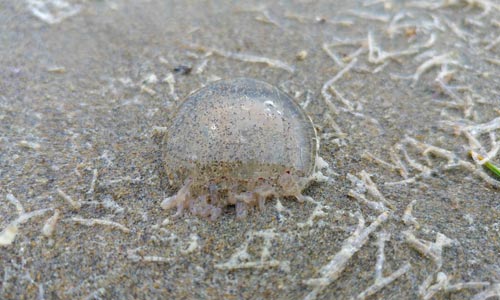Bizarre Finds on Oregon Coast: Pyrosomes, Dolphin, Deformed Velella, Freaky Jellies
Published 11/18/2017 at 5:45 PM PDT
By Oregon Coast Beach Connection staff

(Seaside, Oregon) – It's insanely early to find them, but velella velella and pyrosomes have been spotted on the Oregon coast. Tiffany Boothe, of Seaside Aquarium, made a host of unusual finds in the last 48 hours, including velella (otherwise known as Purple Sails, Purple Sailors or by-the-wind sailors) that were strangely deformed, a dolphin, weird jellyfish called medusas and even some live oysters. (All photos courtesy Tiffany Boothe, Seaside Aquarium).
The Purple Sails and pyrosomes were all very small, indicative of how young they are at this point in the year. These were found at Seaside, Gearhart, Del Rey Beach, Fort Stevens and at Arcadia Beach, near Cannon Beach.
In Seaside, Boothe and the crew discovered two that were deformed, with part of a second sail up top instead of just one.
Fawn Custer, a Seal Rock resident who is a local scientist and the volunteer coordinator for CoastWatch, said finding velella this early in the year is rather remarkable, and the deformed ones are just plain “weird.” Mutations are a regular occurrence in nature, however.
“Happens all the time,” Custer said. “That's why we have children born with random mutations. When the DNA is forming maybe it misses some loops.”
Includes exclusive listings; some specials in winter
In Cannon Beach:
Includes rentals not listed anywhere else
In Manzanita, Wheeler, Rockaway Beach:
Some specials for winter
In Pacific City, Oceanside:
Some specials for winter
In Lincoln City:
Some specials for winter
In Depoe Bay, Gleneden Beach:
Some specials for winter
In Newport:
Look for some specials
In Waldport
Some specials for winter
In Yachats, Florence
Some specials for winter
Mutations are one possibility, but just as likely is the fact velella are colonial hydrozoids and this is a facet of their early development.
“They start out as microscopic jellies, then they go through a metamorphosis to become a body part,” Custer said.
In this case, they are a type of hyrdozoa which start out as tiny jellies but then morph into larger clumps that in turn morph into body parts of the purple sail – what scientists call a colony. They become the sail or one of its other parts. The deformity could be a glitch of that part of their early life.
“It's very early to see them so maybe they're still forming colonies,” she said.
Normally, velella don't show up until spring, but Custer did find some last March, and what was happening with them at such an early development stage back then lends evidence to what's happening now.

Striped dolphin found near Astoria, photo Seaside Aquarium
“They showed up last year in March, which was very early,” Custer said. “And I scooped up a few off the beach and examined them. I found these were still in metamorphosis and that was really interesting.”
Of course, the inevitable (and often laughably conspiratorial) questions arise about radiation leaked into the Pacific from the Fukushima Daiichi Nuclear Power Plant in Japan back in 2011. Custer and Boothe dismiss those, as no credible evidence regarding mutations – including smaller organisms – has ever been found, even in the waters off Japan. Real life is not a Godzilla movie.
Also found by Boothe and the Aquarium crew were the remnants of hatched eggs from Western Nassas (a kind of mollusk), and the really weird Red-Eyed Medusas.
“We found a dozen live bay oysters on the beach near the Peter Iredale!,” Boothe said. “Finally we made it to our stranding call: a six-foot striped dolphin had washed ashore near the South Jetty. The animal was already dead when it came ashore. We recovered the dolphin and will be transferred up to Portland State University where Dr. Debbie Duffield will do a necropsy on it to see if she can determine the cause of death.”
Numerous others along the Oregon coast are reporting finding small velella velella and pyrosomes. Oregon Coast Hotels to look for these creatures - Where to eat - Maps - Virtual Tours More of these creatures below:
Cannon Beach Lodging
Nehalem Bay Lodgings
Manzanita Hotels, Lodging
Three Capes Lodging
Pacific City Hotels, Lodging
Lincoln City Lodging
Depoe Bay Lodging
Newport Lodging
Waldport Lodging
Yachats Lodging
Oregon Coast Vacation Rentals
Oregon Coast Lodging Specials

Tiny Velella and pyrosome

Above and below: a red-eyed Medusa jellyfish

More About Oregon Coast hotels, lodging.....
More About Oregon Coast Restaurants, Dining.....
LATEST Related Oregon Coast Articles
1952: whale would not stay buried. Was it finally entombed in cement. Marine sciences
Final Third of Oregon Coast Given Okay to Start Commercial Crabbing
Majority of the coast began crabbing last week. Marine sciences
Lassoing a Wayward Sea Lion Just Part of the Gig for Oregon Coast Deputies
Sea lion wandering near Newport / South Beach streets got some interesting looks. Marine sciences
Oregon Coast's Crabbing Fleet Heads Out with Whale Entanglement Advisory
Environmental groups petition ODFW for greater whale safety measures. Marine sciences
Commercial Crabbing Cleared for December 16 Opening on Majority of Oregon Coast
Over two-thirds of the coast reopens: the rest hopefully Dec 31. Sciences
Reports of Bird Flu in Washington, Oregon Include Coastlines: States Issue Ad...
One large-scale report from Long Beach still to be determined. Marine sciences
Free Fishing, Crabbing and Clamming in Oregon Nov. 28 - 29, Including the Coast
An outdoorsy tradition for decades now. Events, sciences
Weird Brown Sludge on Oregon Coast / Washington: Turns Out It's a Good Thing
That brown stuff? It's all natural and signs of a healthy ocean. Seaside, Marine sciences
Back to Oregon Coast
Contact Advertise on BeachConnection.net
All Content, unless otherwise attributed, copyright BeachConnection.net Unauthorized use or publication is not permitted













































